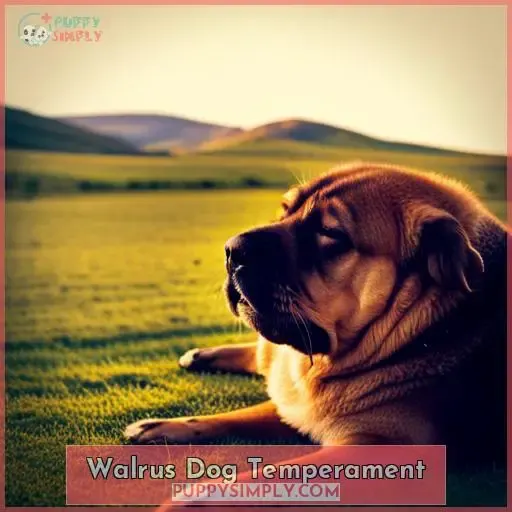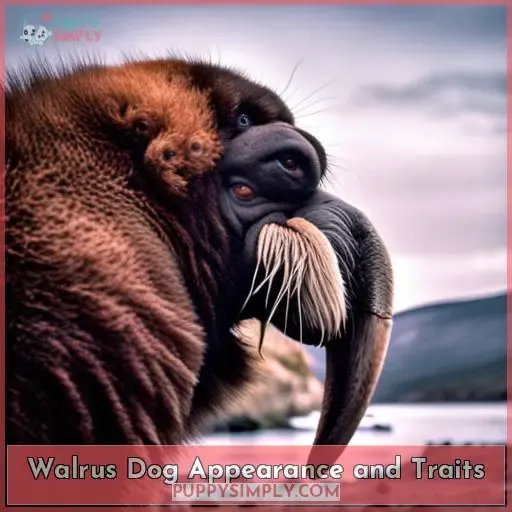This site is supported by our readers. We may earn a commission, at no cost to you, if you purchase through links.

As a mix between a Shar Pei and Basset Hound, the walrus dog blends some of the best traits from both breeds into one lovably goofy package.
Though they can be stubborn, proper training and socialization go a long way.
Give them plenty of playtime and affection, and the loyal walrus dog will make for a delightful addition to any home.
Table Of Contents
- Key Takeaways
- What is the Walrus Dog?
- Walrus Dog Appearance and Traits
- Origins of the Walrus Dog
- Shar Pei History and Traits
- Basset Hound History and Traits
- Walrus Dog Temperament
- Walrus Dog Health Concerns
- Exercise Needs of the Walrus Dog
- Suitability as a Family Pet
- Walrus Dog Rescue and Adoption
- Frequently Asked Questions (FAQs)
- Conclusion
Key Takeaways
- Originated in the 1990s United States by crossing Shar Pei and Basset Hound breeds
- Strong-willed, stubborn temperament presents training challenges despite intelligence
- Health issues like joint problems common due to inherited genetic predispositions
- Experienced owners suited to meet demands of training and proper care for the breed
What is the Walrus Dog?
Your Walrus Dog is a designer crossbreed mixing the Chinese Shar Pei and the British Basset Hound.
This unique canine fusion blends traits from two distinct breeds into a Basset blend that serves as a loyal companion.
As a Shar Pei hybrid, the Walrus dog exhibits some of the traditional Chinese breed’s strong guarding instincts and independence along with the charming scent-tracking talents of the low-slung Basset Hound.
Though more research on this mixed breed is needed, the Walrus dog temperament trends toward protectiveness, wariness of strangers, and attachment to family.
Proper socialization and training can help this hybrid canine become an affectionate and amusing pet in the right home environment.
With striking folds and a distinctive waddle, the Walrus dog’s appearance lives up to its amusing moniker.
Walrus Dog Appearance and Traits
When it comes to the Walrus Dog’s looks, you’ll notice:
- Its short, harsh coat and loose skin with folds.
This medium-sized crossbreed typically:
- Stands 10-13 inches tall.
- Weighs between 30-50 pounds.
Coat colors for the Walrus Dog include:
- Golden
- Brown
- White
- Black
- Cream
- Chocolate
- Fawn
Coat and Colors
Its coat and colors set the walrus dog apart, with a short, harsh coat and loose skin showing in hues of golden, brown, white, black, cream, chocolate, or fawn.
As a mixed breed, grooming routines focus on brushing out that distinctive coat twice weekly and regular baths to clean wrinkles and folds.
Their training challenges stem from the stubborn streak of their Shar Pei lineage, requiring dedicated socialization and positive reinforcement to curb chasing instincts.
With genetic health risks, their family compatibility shines through loyal protection balanced by affection.
Size and Weight
You’ll find this mix typically stands 10-13 inches tall and weighs between 40 and 65 pounds when fully grown.
Given the body type of the parent breeds, weight can fluctuate considerably in the Walrus dog.
Appropriate exercise is essential to maintain good musculoskeletal health and prevent obesity, which could exacerbate joint issues.
The compact size of this crossbreed means they can adapt to apartment living, provided their activity needs are met through daily walks and play.
Their training should factor in size considerations like stair use.
Monitor their diet and fitness levels vigilantly.
Origins of the Walrus Dog
This mixed breed likely originated in the United States in the 1990s when breeders crossed Shar Peis and Basset Hounds.
The parent breeds have distinct histories:
- Shar Peis originate from China, where they were initially hunting dogs and later used for dog fighting. They were brought to the U.S. in 1973 in an effort to save the breed from extinction.
- Basset Hounds descended from French dogs that were bred in Britain in the 1800s specifically for hunting. They were popular among French aristocrats. The AKC registered the Basset Hound breed in 1885.
Crossing these two pure breeds resulted in the Shar Pei and Basset Hound mix now known as the Walrus Dog.
Shar Pei History and Traits
Coming from the Chinese origin of the Shar Pei parent breed, you’re looking at dogs initially used for hunting and later for dog fighting.
Brought to the U.S. in 1973 to save the breed from extinction, the American Kennel Club recognized the Shar Pei in 1992.
Shar Pei Traits
- Skin: Loose and wrinkly
- Coat: Short, coarse, and bristly
- Color: Solid or sable colors like red, fawn, cream, black, blue, silver
- Size: 18-20 inches tall, 40-60 pounds
- Temperament: Independent, stubborn, protective, devoted
The Shar Pei is known for its unique loose skin and wrinkles. Though originally a working dog bred for hunting and fighting, they make devoted companions when properly trained and socialized. The Shar Pei traits lend unique characteristics to the Walrus Dog when mixed with the Basset Hound.
Basset Hound History and Traits

Coming from Chinese hunting roots, the loyal yet stubborn Shar Pei found its way into many American homes.
Now, let’s turn our attention to the other half of this charming mix – the Basset Hound.
With its long droopy ears, sad eyes, and charming personality, the Basset charmed French aristocrats as early hunting companions in the 1800s.
Though initially prized for its keen sense of smell during hunts, today the Basset is better known as a family-friendly and patient pup.
Recognized by the AKC in 1885, the Basset contributed its signature ears, nose, and family-loving temperament to give the Walrus Dog its endearing and goofy appearance that owners have come to adore.
But those looks come at a health cost that we’ll explore next.
Walrus Dog Temperament

When it comes to the temperament of a Walrus Dog, there are a few important factors to consider.
First, training can be challenging due to their stubborn streak inherited from both parent breeds. It’s crucial that you provide consistent and reward-based training methods to promote obedience and calmness.
Additionally, early socialization is essential for them to develop good behavior around strangers and other animals.
Training Difficulties
You’ll find the Walrus Dog’s stubborn streak makes training challenging for even experienced owners.
Their strong-willed temperament and hunting instincts mean they can be difficult to train.
Consistency and positive reinforcement are key when working on obedience struggles resulting from their independent nature.
Early socialization helps curb behavioral problems.
Consider professional training if encountering handling or temperament issues.
Their intelligence means they’re able to learn, but their stubbornness necessitates creative, patient methods tailored to overcoming their stubborn streak.
Socialization
You should also properly socialize your Walrus dog from a young age due to their potential stubbornness with strangers.
Arrange regular canine friendships and puppy playdates to teach good manners, curb antisocial tendencies, and train acceptable behaviors.
Despite socialization challenges stemming from their Shar Pei lineage, consistency, positive rewards, scheduling breaks, and making slight behavioral adjustments will yield a friendly, well-adjusted dog.
Walrus Dog Health Concerns

Coming from the challenges of training this mixed breed, we must consider the Walrus Dog’s health.
As designer dogs, they inherit genetic predispositions from both parent breeds.
Regular veterinary check-ups and preventive care are crucial, as are health screenings for common issues like joint dysfunction, eye disease, skin conditions, and spinal problems.
Support holistic well-being through proper nutrition, exercise, socialization, training, and veterinary care.
Though crossbreeding aims to minimize certain disorders, these dogs still face higher health risks than the average pup.
Do your part by staying informed on their needs, getting tests done, and not supporting irresponsible breeding practices.
Give rescue Walrus Dogs loving homes, as shelters vet them for medical issues.
Exercise Needs of the Walrus Dog
Get your Walrus Dog out for daily moderate exercise to keep this mix fit and healthy.
As a medium-sized breed, the Walrus Dog needs activity to prevent obesity and joint issues. However, be mindful of overheating and breathing issues due to the Basset Hound lineage.
| Activity | Duration | Frequency |
|---|---|---|
| Walking | 30 minutes | Daily |
| Playing fetch | 15-20 minutes | 2-3 times weekly |
| Training sessions | 15-20 minutes | 2-3 times weekly |
Mental stimulation is also crucial. Engage your Walrus Dog’s intelligence through playful exercises like hide-and-seek and through consistent obedience training.
Not only does this provide an outlet for their minds, but it reinforces the human-canine bond that this loyal mix craves.
Maintaining a regimen of physical and mental activity keeps the Walrus Dog fit, healthy, and happy.
Suitability as a Family Pet
Its demanding training and socialization requirements make the Walrus Dog best suited to experienced dog owners committed to proper obedience work.
They form strong bonds with family members and enjoy lots of affection, but may suffer from separation anxiety if left alone for long periods.
Their hybrid vigor means they tend to have fewer health issues than purebred parent breeds.
However, they still require regular vet checks and grooming due to skin fold infections.
Rescuing a Walrus Dog can be very rewarding, providing an unwanted hybrid dog a loving home.
While challenging, Walrus Dogs can make loyal and fun-loving family companions with proper care, training, and socialization from an early age.
Their cute wrinkly faces may tempt impulse buyers, but these dogs need knowledgeable owners ready for their demanding traits inherited from Shar Pei and Basset Hound parentage.
Walrus Dog Rescue and Adoption
When considering a Walrus dog, we encourage you to explore adoption options first.
Shelters and rescues carefully screen each dog for health and behavior issues, providing you with full transparency into their background.
Adopting also reduces demand on questionable breeders and gives an unwanted dog a second chance at a happy home.
Benefits of Rescue
Rescuing a Walrus dog provides companionship while reducing the demand for irresponsible breeding practices.
Adopting a rescue Walrus dog offers many rewards:
- Rescue Rewards: The satisfaction of providing a home to a dog in need.
- Adopted Joy: The happiness shared between adopter and adopted dog.
- Second Chances: Supporting dogs who deserve another opportunity.
By adopting a Walrus dog from a shelter, you open your heart and home to a deserving canine companion while promoting responsible dog ownership.
Health Screening
When adopting your rescue Walrus Dog:
- Request its medical records and ask the shelter about any prior health screening to understand your new pet’s health status.
- This allows you to provide preventive care tailored to your dog’s needs.
- Prior genetic testing also equips you to anticipate potential health issues.
Regular veterinary check-ups, plus holistic wellness approaches, further support your Walrus Dog’s wellbeing.
Frequently Asked Questions (FAQs)
What is the lifespan of a walrus dog?
The average lifespan of a walrus dog is 8 to 13 years.
However, you’ll want to keep an eye out for health issues common to their Shar Pei and Basset Hound parent breeds.
With proper care and prevention, your Walrus can live a happy life at the upper end of that range.
How much grooming and shedding can I expect from a walrus dog?
With regular brushing, you’ll keep the short coat neat.
Bathe as needed.
Low shedding, but wrinkles require diligent fold cleaning and drying to prevent infection.
How much does a walrus dog puppy cost?
You should expect to pay $500-1000 for a walrus dog puppy.
As they say, you get what you pay for, so be wary of puppies priced much lower or higher.
Do your research to find a reputable breeder offering healthy pups worth the investment.
Are walrus dogs good with other pets like cats?
Walrus dogs can have a strong prey drive.
Therefore, they may not be the best fit for homes with cats or other small pets.
It’s important to consider their instincts and provide proper training and socialization.
How do I find a reputable walrus dog breeder?
Check breed clubs for referrals.
Visit facilities and meet dogs.
Ensure proper health testing.
Confirm commitment to puppy socialization and training.
Trust instincts when evaluating breeders.
The right one prioritizes puppy welfare over profit.
Conclusion
As the old adage goes, adopt, don’t shop.
If you’re seeking a devoted companion with an amusing personality, consider rescuing a Walrus Dog.
Though training can prove challenging, proper socialization and firm leadership will ensure a well-adjusted pet.
Provide ample stimulation, and your wrinkly buddy will flourish into a fun, faithful friend for years to come.
With appropriate care for their unique needs, the Walrus Dog makes a delightful furry addition to active homes.













